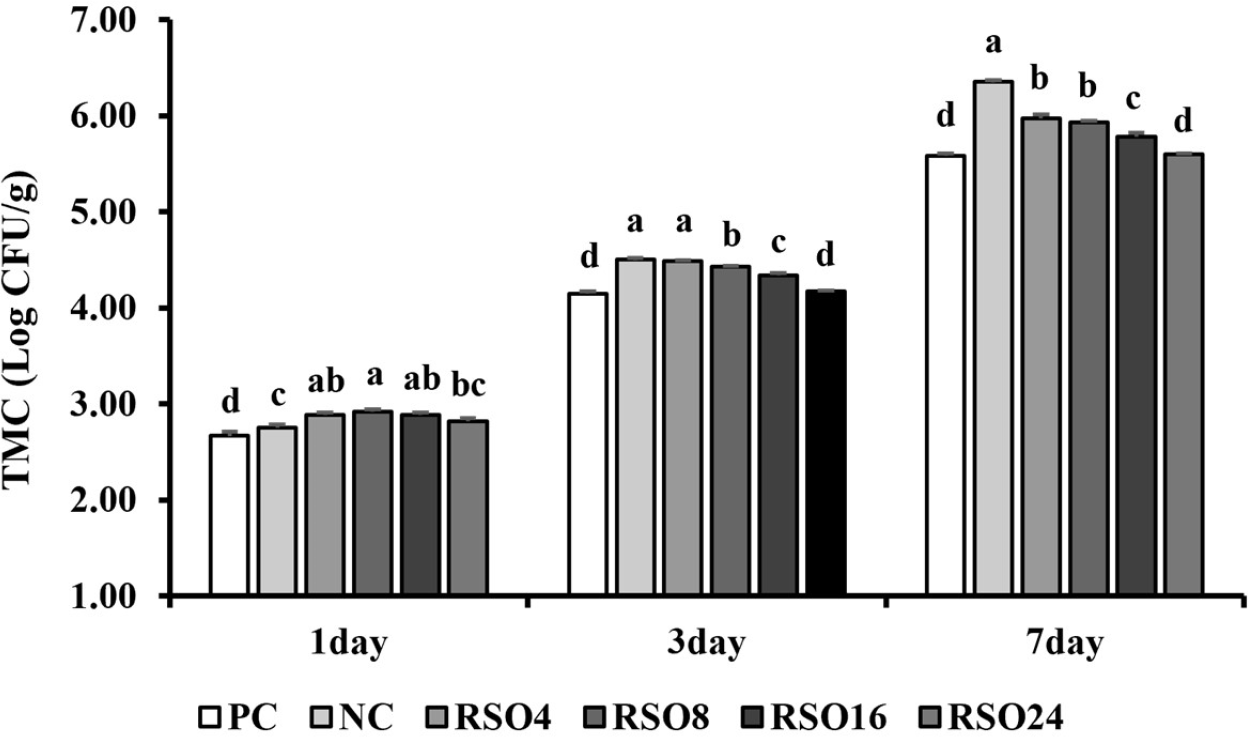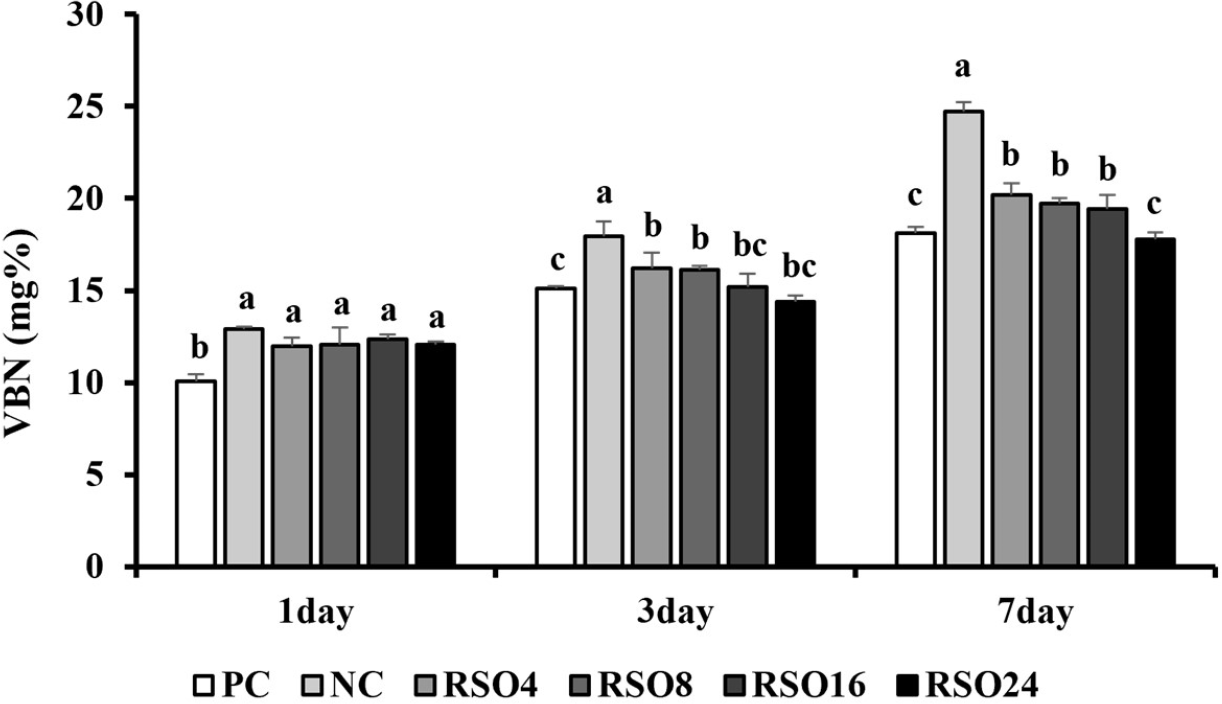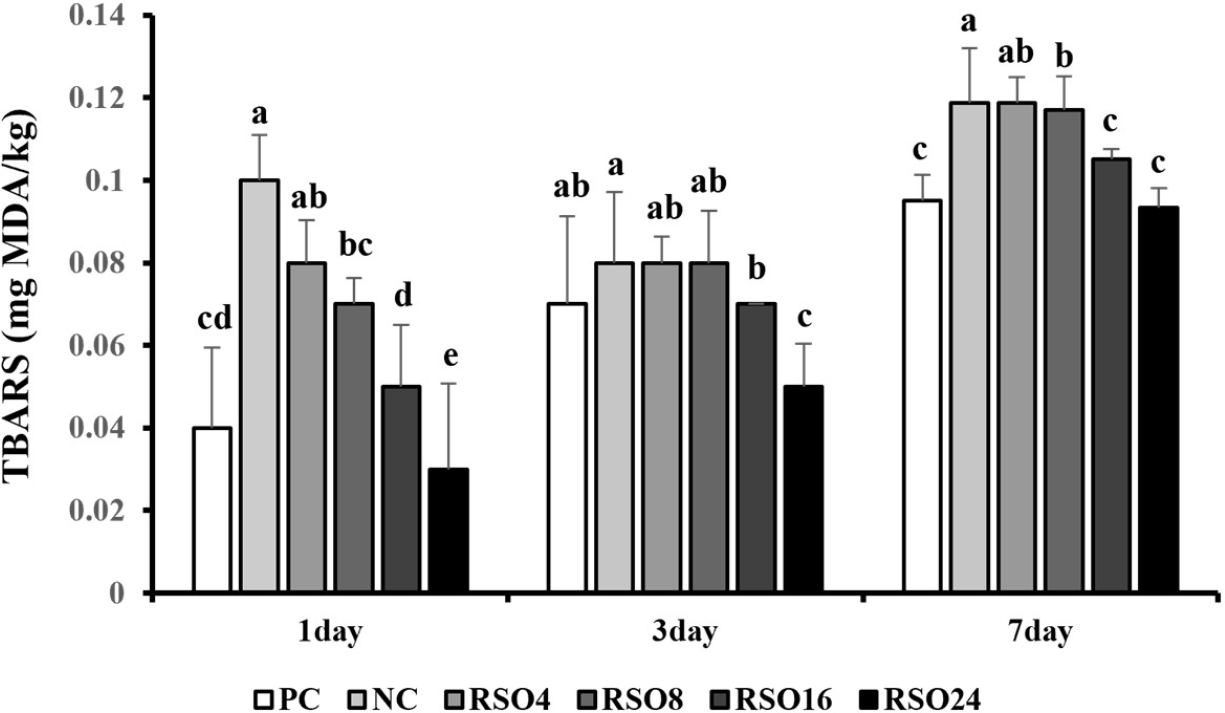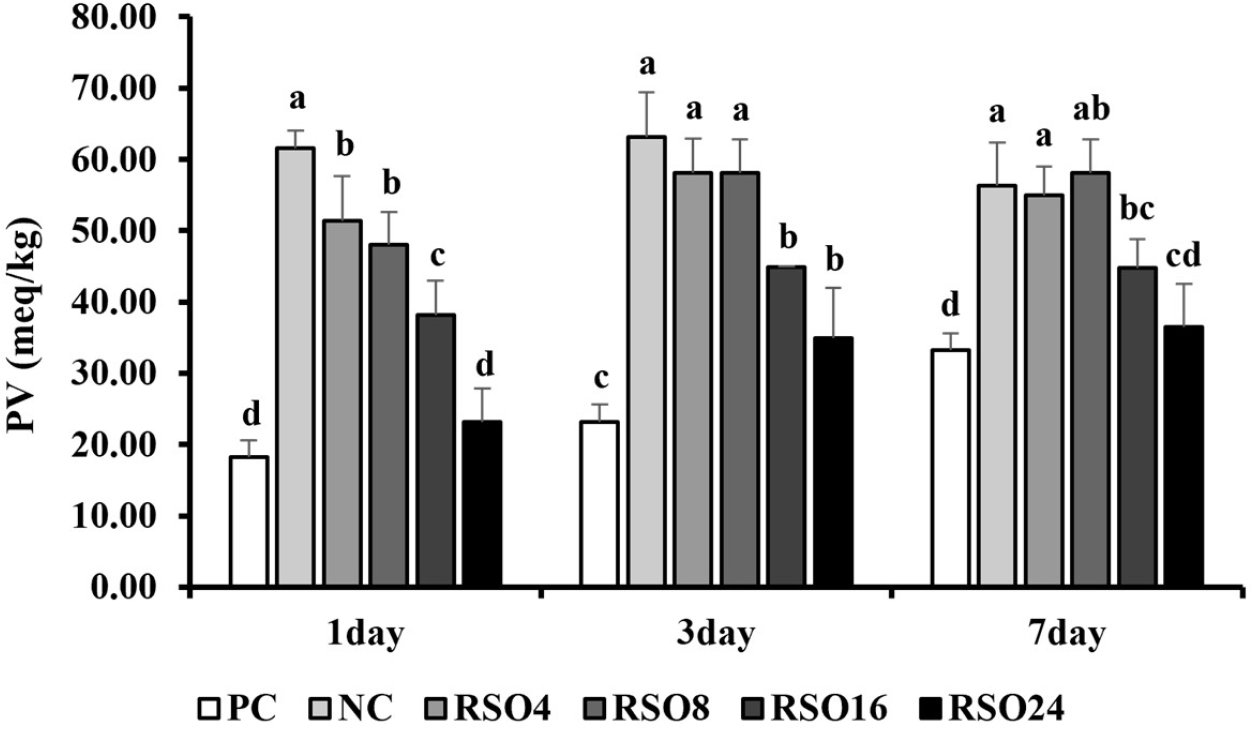Introduction
The worldwide consumption of meat products has been gradually increasing with population growth and rising average personal incomes (Godfray et al., 2018). Accordingly, the meat processing industry has also rapidly increased in recent years, and it is now expected to meet the needs of consumers interested in health (Jeong, 2016). Health functional food may vulnerable to a risk of microbial growth and fatty acid spoilage because it does not initially contain compounds such as preservatives or antioxidants. Microbial growth and fatty acid oxidation are thus considered to be major problems that impair the storage properties of these ground meat products (Shan et al., 2009). Therefore, when manufacturing processed meat products, chemical food additives are added to improve storage properties. However, nitrite—which is an additive that is mainly added to improve the functionality of processed meat products—has been suggested to form N-nitroso compounds in the body, and substances including nitrosamine can cause carcinogenicity (WHO, 2022). Although the amount of such food additives is regulated by the Food Sanitation Act (KFDA, 2023), consumers prefer processed meat products using natural additives because of negative perceptions of chemical additives and concerns about the adverse effects of ingesting large amounts of such additives. This had led to active research examining the founding of new types of value using food byproducts.
Due to their antioxidant and antibacterial properties, essential oils and various plant extracts can serve as alternatives to chemical additives (Bañón et al., 2007). Vegetable oil extracted from seeds has the advantage of containing a high proportion of mono- or polyunsaturated fatty acids and no cholesterol, and when added to meat, it can increase the proportion of monounsaturated fatty acids such as oleic acid (Bloukas and Paneras, 1993). Among these vegetable oils, radish seed oil (RSO) and canola oil have been traditionally used; cruciferous oils have yet to be popularized despite having similar properties (Ratanapariyanuch et al., 2013). Cruciferous species are reported to confer several health benefits, including antioxidant and antibacterial activity (Avato and Argentieri, 2015).
Radish (Raphanus sativus L.) is a vegetable belonging to the cruciferous species that is consumed worldwide, and it contains bioactive compounds that are beneficial to human health. Radish seeds have also been reported to reduce the level of tumors and to be effective in preventing diabetes (Banihani, 2017). RSO is composed of unsaturated fatty acids, which can reduce the cholesterol content of meat products. Moreover, RSO includes compounds such as tocopherol, glucosinolate, and sulforaphene, which have antioxidant and antibacterial activities which are beneficial to the human body (Carlson et al., 1985; Zhao et al., 2017). Therefore, the current study investigated the antioxidant activity of RSO by analyzing the quality and storage characteristics of pork patties prepared with various amounts of RSO.
Materials and Methods
The radish seeds used in this study were provided by PPS Co., Ltd. For low-temperature cold pressing extraction, 200 g of seeds was extracted using a cold press machine (NF-80, Karaerler, Ankara, Turkey) set at 18 Hz and 49°C. During the oil extraction process, a thermometer was used to ensure that the temperature of the machine and oil did not exceed 49°C. The extracted oil was collected using a vacuum filtration pump and filter paper to remove impurities, resulting in the collection of pure oil. The oil extraction yield was measured to be 20.84%, while the oil moisture content was measured to be 1.12%.
The fatty acid composition was analyzed using the AOAC validated method, which involved methylation followed by gas chromatography. For fat hydrolysis, a sample of 25 μL was treated with 1.5 mL of 0.5 N NaOH·MeOH. Next, a mixture of 2 mL of 14% boron trifluoride methanol solution, 2 mL of 2,2,4-trimethyl pentane, and 5 mL of saturated NaCl was added, and this mixture was then kept at room temperature for 15 min for fatty acid derivatization. Once the layers had separated, the upper layer was filtered through a 0.45 μM membrane filter (Millipore, Billerica, MA, USA) and used as the sample for fatty acid composition analysis. At this point, the sample was injected into a gas chromatography instrument (HP 6890N/5973N MSD, Agilent Technologies, Wilmington, DE, USA) equipped with a flame ionization detector for analysis of the fatty acid composition. The gas chromatography column used was HP-INNOWAX (60 m×0.25 mm×0.25 nm, Agilent, Santa Clara, CA, USA). The column was held at 120°C for 5 min, after which the temperature was increased at a rate of 5°C per min until reaching 240°C, where it was maintained for 20 min. The injection temperature was set at 25°C, while the detector temperature was set at 300°C. Nitrogen (N2) was used as the carrier gas. To determine the fatty acid composition, the peaks corresponding to fatty acids in the sample were identified through comparison with a standard (CRM18918, Sigma-Aldrich, St. Louis, MO, USA). The relative composition of each fatty acid was calculated as the ratio of the area sum of each fatty acid to the total area sum of all fatty acids.
The radical scavenging activity was measured using the 2,2-diphenyl-1-picrylhydrazyl (DPPH) method. For the DPPH test, a small amount of DPPH solution was dissolved in ethyl acetate and adjusted to an absorbance of 0.700±0.020 at 520 nm. The DPPH solution was then diluted with ethyl acetate. Next, 40 mg of the oil sample was weighed in a test tube, to which 160 μL of ethyl acetate and 5.8 mL of DPPH· free radical solution were added. The sample was then vortexed for 20 s. After incubation in a dark room for 30 min, the absorbance of ethyl acetate was measured at 520 nm.
To begin, 1.0 g of the sample was placed in a triangular flask. Then, 10 mL of chloroform was added to dissolve the sample completely, after which 15 mL of acetic acid was added for mixing. A saturated KI solution was prepared by dissolving potassium iodide (99%) and distilled water in a 7:3 ratio. Next, 1mL of the saturated KI solution was added to the flask, which was then sealed and vigorously shaken for about 1 min, followed by incubation at room temperature for 10 min in a dark room. After that, 30 mL of distilled water was added, and the mixture was homogenized again. At this point, 1 mL of 1% starch indicator solution was added, and the mixture was titrated with 0.01N Na2S2O3 standard solution until it turned colorless. A blank test was also conducted in parallel with the actual experiment.
Pork patties with radish seed oil (RSO) added were prepared as described in Table 1. There are six treatments in total: positive control (tocopherol 0.1%+sodium nitrite 0.01%), negative control, RSO4 (RSO 0.4%), RSO8 (RSO 0.8%), RSO16 (RSO 1.6%), and RSO24 (RSO 2.4%). The ground pork and materials were mixed for 5 min, then divided into 100 g each and molded into a 10 cm diameter and a 1 mm thickness using a patty molding machine. The prepared patty was aged for one day through refrigeration for 24 h before being used as a sample for the experiment. After aging for one day after manufacturing, proximate composition, pH, water holding capacity (WHC), cooking loss (CL), color, texture profile analysis (TPA), and sensory evaluation were conducted. Total microbial count (TMC), volatile basic nitrogen (VBN), thiobarbituric acid reactive substances (TBARS) and peroxide value (PV) were measured while they were frozen for the storage period (1, 3, and 7 days). All experiments were performed in triplicate.
Proximate component analysis was performed according to the Association of Official Analytical Chemists (AOAC, 2012) method. Moisture was analyzed using the atmospheric pressure drying method at 105°C, protein was analyzed using the Kjeldahl method, crude fat was analyzed using the Folch extraction method, and ash was analyzed using the direct ashing method.
After taking 5 g of the sample, the mixture with 50 mL of distilled water was homogenized with a stomacher for 30 s. Then, after immersing the electrode in the sample solution so that it was submerged, the value was derived by reading the value displayed on the pH meter.
0.5 g of ground meat was placed in the upper filter tube of a centrifuge tube. The weight was measured, and then the filter tube was heated in an 80°C water bath for 20 min. After that, the filter tube was placed in the lower part of the centrifuge tube and centrifuged at 448×g for 10 min. The filter tube was then removed, and the weight was measured again.
The CL of the meat was determined by cutting the sample into cubic shapes that were approximately 50 g. The sample was then heated in a 70°C water bath for 30 min. The percentage of CL was calculated by subtracting the weight after cooking from the weight before cooking, dividing it by the weight before cooking, and multiplying by 100.
The color measurements were carried out using a color meter or spectrophotometer (CM-26d, Minolta, Japan) according to the specifications set by the International Commission on Illumination (CIE). The measurements included the values for CIE L*, CIE a*, and CIE b*. The average values were recorded to represent the color characteristics of the meat. Color was measured after cooking the pork patties.
The TPA was conducted using a rheometer (Model Compac-100, Sun Scientific, Dobbs Ferry, NY, USA). The measurements included hardness, springiness, cohesiveness, chewiness, and gumminess. The load cell was set at 10 kg, while the cross-head speed was set at 200 mm/min. TPA was measured after cooking the pork patties.
A sample of 10 g is taken and mixed with 90 mL of 0.1% peptone solution in a stomacher. The mixture is homogenized at 4×g for 30 s. After that, the sample is serially diluted and inoculated onto plate count agar (PCA) plates, which are then incubated at 36°C for 48 h. After 48 h, the microbial count is determined using a colony counter. The TMC is expressed in Log CFU/g.
A sample of 10 g is mixed with 90 mL of distilled water. The mixture is then homogenized at 11,200×g using a homogenizer, before being filtered using a Whatman No. 2 filter. At this point, 3 mL of the filtrate is transferred to the outer chamber of a Conway unit, and 1 mL of 0.01N boric acid and two to three drops of an indicator are added to the inner chamber. The unit is sealed, and 1mL of 50% K2CO3 is quickly injected into the outer chamber. After sealing the unit with a clip, it is incubated at 36°C for 2 h. The boric acid solution in the inner chamber is then titrated with 0.02N H2SO4. The VBN value is expressed as mg percent 100 g of sample.
A sample of 10 g is mixed with 15 mL of cold 10% perchloric acid and 25 mL of 3rd-distilled water in a homogenizer. Next, the mixture is homogenized at 11,200×g for 10 s. The homogenate is then filtered using Whatman No. 2 filter paper. At this point, 5 mL of 0.02M TBARS solution is added to 5 mL of the filtrate, and they are thoroughly mixed. After the mixture is allowed it to stand for 16 h in a cold room, the absorbance at 529 nm is measured using a spectrophotometer. A blank using 3rd-distilled water is also measured. The TBARS value is expressed in terms of TBARS values, specifically as mg malonaldehyde per kg of sample. The standard curve used for calculation is y=0.1975×–0.0011 (r=0.999), where y represents the absorbance and × represents the TBARS concentration.
The researchers conducted a sensory evaluation to assess the overall preference of the product. The following attributes were measured using a nine-point scale: color, flavor, smell, juiciness, texture, and overall preference. For color, a score of 1 indicated a lighter shade, while a score of 9 indicated a darker shade. For flavor, a score of 1 represented poor taste, while a score of 9 represented excellent taste. For smell, a score of 1 indicated an unpleasant odor, while a score of 9 indicated a pleasant odor. For juiciness, a score of 1 represented dryness, while a score of 9 represented high juiciness. For texture, a score of 1 indicated softness, while a score of 9 indicated firmness. Lastly for overall preference, a score of 1 represented a negative acceptability, while a score of 9 represented a positive acceptability. This study was approved by the institutional review board (IRB) at Chungbuk National University (IRB approval number: CBNU-202302-HR-0016).
All experiments were measured in triplicate. Statistical analysis was performed using the GLM (General Linear Model) method run in the SAS 9.4 program (SAS Institute, Cary, NC, USA). Mean comparisons within traits grousps were conducted using one-way ANOVA followed Duncan’s multiple range test (p<0.05).
Results and Discussion
Table 2 presents the fatty acid composition of RSO. The identified fatty acids in RSO are classified into groups such as saturated, monounsaturated, and polyunsaturated fatty acids. Of the total fatty acid content, saturated fatty acids account for 9.53%, monounsaturated fatty acids account for 67.10%, and polyunsaturated fatty acids account for 23.38%. It is evident that RSO has a higher content of unsaturated fatty acids than saturated fatty acids. The major fatty acids present include oleic acid, linoleic acid, linolenic acid, and erucic acid. They respectively constitute 46.13%, 13.16%, 10.22%, and 20.75% of the total fatty acids.
This fatty acid composition is similar to that of RSO as reported by Kazlauskienė et al. (2021) and Uluata and Özdemir (2011). Linoleic acid and linolenic acid have been reported to reduce the incidence of cancer and cardiovascular diseases (Parker et al., 2006). However, RSO contains erucic acid, which is a naturally occurring toxic substance that includes the accumulation of triacylglycerol in the heart as a result of insufficient oxidation (Waheed et al., 2019). Large amounts of erucic acid are also present in RSO, but research suggests that by carefully considering the variety of RSO and the beneficial components present, the intake of erucic acid can be reduced when used for consumption (Wendlinger et al., 2014). It is therefore recommended that the variety of radish seeds should be carefully considered to minimize the intake of toxic substances.
The PV and DPPH measurements of RSO are as listed in Table 3. Measuring hydroperoxides, which are the primary oxidation products of oil, is an important aspect of evaluating the oxidative status and quality of the oil. PV is commonly measured to assess the degree of lipid oxidation, with higher values indicating higher levels of oxidative rancidity in vegetable oils (Kyari, 2008). The PV of RSO was measured at 2.75±0.15 meq/kg, which is within the Codex standard value of 10 meq/kg.
| Traits | PV (meq/kg) | DPPH (%) |
|---|---|---|
| Radish seed oil | 2.75±0.15 | 75.46±3.7 |
The DPPH assay is used to measure the free radical scavenging ability of antioxidants, and it is useful for assessing the antioxidant activity of food (Marinova and Batchvarov, 2011). DPPH is a stable free radical, and its proton is reduced by the electron-donating ability of substances with antioxidant activity, thus allowing for estimation of the sample’s antioxidant capacity (Katsube et al., 2004). The DPPH value of RSO was measured at 75.46±3.7%. Compared to grape seed oil and sesame oil, both of which are known for their high antioxidant activity with radical scavenging abilities of 43.50% and 63.88%, respectively (Kim et al., 2019), the DPPH value of RSO is relatively high. The relatively high antioxidant activity of RSO is believed to be due to the high contents of vitamin E and unsaturated fatty acids present in cold-pressed extracted seed oil.
Table 4 presents the results of measuring the proximate composition of pork patties prepared with varying amounts of RSO. There was no significant difference in moisture content between PC and RSO4 (p>0.05), while moisture content showed a decreasing trend with increasing levels of tocopherol and RSO added. Regarding protein content, PC and RSO24 showed similar values (p>0.05). Overall, the addition of RSO resulted in an increase in fat content, which led to relative decreases in both moisture and protein content. Ash content did not show significant differences among all treatment groups (p>0.05).
Table 5 presents the results of measuring the pH, WHC, and CL of pork patties manufactured with varying levels of RSO addition. There were no significant differences in pH between PC, NC, and RSO4 (p>0.05). The pH of the RSO used in this experiment was 4.58, thus indicating slight acidity. Therefore, as the level of added RSO increased, there was a tendency for pH to decrease.
Regarding WHC, there were no significant differences between PC, NC, RSO4 and RSO8 (p>0.05); however, there was a decreasing trend with increasing levels of added RSO (p>0.05). WHC shows a minimum value around the isoelectric point of myosin and actomyosin, which is around pH 5.2–5.4. When pH either increases above or decreases below this point, the meat’s WHC increases (Zayas, 1997). It can therefore be inferred that the decrease in pH influenced the decrease in WHC.
There were no significant differences in CL between PC, NC, RSO4 and RSO8 (p>0.05), but CL was significantly lower in RSO16 and RSO24 (p<0.05). These results are consistent with the findings of Dzudie et al. (2004), who reported that vegetable fat has lower WHC and higher CL than animal fat. Similarly, López-López et al. (2011) and Paneras and Bloukas (1994) found that CL increases when vegetable fat is added during the production of meat products. The addition of plant fibers such as rice bran fiber, locust bean gum, and xanthan gum has been reported to help preserve CL when replacing pork fat with vegetable fat (Lurueña-Martínez et al., 2004). Therefore, when manufacturing pork patties, the addition of plant fiber can enhance cohesion with vegetable oil, maintain WHC, and improve emulsion stability to compensate for CLs.
Table 6 lists the results of measuring the color of uncooked pork patties manufactured with varying levels of RSO addition. In terms of CIE L*, the treatment groups with added RSO showed significantly higher values compared to PC (p>0.05). For CIE a*, there were no significant differences between NC, RSO4, RSO8, and RSO16, but PC showed significantly lower values (p<0.05). The lower values of CIE L* and CIE a* in PC can be attributed to the addition of dark-colored tocopherol. For CIE b*, RSO4 showed significantly lower values (p<0.05) than other samples; on the other hand, there were no significant differences in CIE b* between PC and the other treatment groups (p>0.05). CIE b* tended to increase slightly with increasing levels of added RSO, as RSO contains carotenoids, which are natural pigments that contribute to the yellow color (Zhao et al., 2017). Therefore, RSO can be used as an additive to increase the CIE b* of meat products.
Table 7 presents the results of measuring the TPA of pork patties manufactured with varying levels of RSO added. In terms of hardness, there was no significant difference between PC and RSO16 (p>0.05), but RSO24 showed a lower value than PC (p<0.05). Regarding cohesiveness, no significant difference was observed between PC and the treatment group (p>0.05). For springiness, there was no significant difference between PC and RSO8 or RSO16 (p>0.05), but RSO24 showed a lower value than PC (p<0.05). In terms of gumminess, there was no significant difference between PC and RSO16 (p>0.05), but RSO24 showed a lower value (p<0.05). There was no significant difference in chewiness between PC and RSO16 (p>0.05). These findings are consistent with the results reported by Matulis et al. (1995) and Park et al. (2005), who observed a significant decrease in the chewiness of beef patties with the addition of vegetable oil. These results are also consistent with the results reported by Monteiro et al. (2017), who found that the texture characteristics of pork sausages with canola oil added were lower than those of the control group. As a result, it can be concluded that adding plant-based oil to pork patties without any pre-treatment leads to high CL and negatively affects the tissue characteristics. Overall, RSO16 appears to show the best texture profile, as it does not exhibit any significant differences compared to PC. Additionally, hydrophilic binders such as carrageenan have been reported to aid in the emulsification of plant-based and meat products (Choi et al., 2019). Therefore, we suggest using a hydrophilic binder when utilizing vegetable oil to improve the texture of meat products.
The results of measuring the TMC of pork patties manufactured with varying levels of RSO added on each storage day are shown in Fig. 1. An increasing level of RSO on each storage day was shown to be associated with a tendency of decreasing TMC. Among the 7-day samples, NC exhibited the highest value, while the RSO24 showed the lowest values (p<0.05). Radish seeds contain health-promoting compounds such as sulforaphene and glucosinolates, which are found in cruciferous vegetables (Gutiérrez and Perez, 2004). Sulforaphene is a bioactive compound with anticancer effects that induces cell apoptosis and which has a similar chemical structure to sulforaphane isolated from broccoli seeds (Lim et al., 2020). Glucosinolates are organic compounds that are known for their powerful antimicrobial and anticancer properties. According to Mendiratta et al. (2013), adding radish to lamb nuggets resulted in lower microbial counts compared to the control group. This finding is consistent with a report by Lay and Anderson (2005) that suggests that domestic radish seeds possess strong antimicrobial properties. RSO has been shown to be effective as a natural antimicrobial agent in food products.

The results of measuring the VBN of pork patties manufactured with varying levels of RSO added on each storage day are shown in Fig. 2. On day 1 of storage, PC exhibited the lowest value (p<0.05), and there was no significant difference observed among the NC and treatment groups (p>0.05). However, at day 3 and day 7, RSO16 and RSO24 showed significantly lower values than NC (p<0.05). There was also a tendency for a slight decrease in VBN values as the level of RSO increased. VBN content increases during storage due to the breakdown of proteins into amino acids through bacterial action, thus indicating that there is a close relationship between VBN content and bacterial proliferation (Kruk et al., 2011). Therefore, the inhibition of protein spoilage by RSO is attributed to the tocopherol compounds present in RSO, which inhibit bacterial growth. However, domestic food hygiene regulations mandate that the VBN content be kept below 20 mg% for raw and packaged meat (KFDA, 2009). It is therefore inferred that the shelf life of pork patties with RSO addition is within 7 days.

The results of measuring the TBARS and PV of pork patties manufactured with varying levels of RSO added on each storage day are shown in Figs. 3 and 4. In the case of TBARS, at day 1 and day 3, RSO24 showed values that were significantly lower than those in any of the other treatment groups, while at day 7, PC, RSO16, and RSO24 exhibited the lowest values (p<0.05).


For PV, there was no significant difference observed between PC and RSO24 on days 1 and 7 (p>0.05). Both TBARS and PV showed a tendency of decreasing with an increasing level of RSO. This is consistent with the study by Kazlauskienė et al. (2021), which reported that RSO has strong antioxidant activity. Plant-based oils contain large amounts of phenolic compounds. RSO contains approximately 599.15 mg/kg of tocopherol (Uluata and Özdemir, 2011). Tocopherol, also known as vitamin E, is a natural antioxidant that has phenolic hydroxyl groups that are capable of scavenging free radicals. It has the ability to bind to proteins and macromolecules and exhibits antioxidant activity (Manessis et al., 2020). The U.S. Food and Drug Administration (FDA) has included tocopherol in its list of Generally Recognized as Safe (GRAS) substances after evaluating its safety. Therefore, adding RSO to meat products is expected to inhibit fat oxidation and effectively act as an antioxidant.
Table 8 presents the results of the sensory evaluation of pork patties prepared with different levels of RSO. In terms of color, PC showed significantly lower values (p<0.05). This is consistent with the lower CIE L* observed in PC, which can be attributed to the addition of dark-colored tocopherol. For flavor, the treatment groups with RSO added showed significantly higher values compared to the control group (p>0.05). In terms of smell, RSO4 and RSO8 showed significantly higher values compared to the control group (p>0.05). These results are consistent with the findings of Muguerza et al. (2002), who observed higher ratings for flavor and smell in low-fat sausages that had been supplemented with olive oil. In juiciness, treatment groups with RSO added were significantly lower than PC (p<0.05). There was also a tendency of decreasing juiciness as the amount of RSO added increased. This can be attributed to the decreasing moisture content and increasing CL with increasing levels of added RSO. Texture showed no significant difference among all treatment groups (p>0.05). In terms of overall preference, the treatment groups showed significantly higher values compared to the control group (p<0.05), and RSO16 with 1.6% RSO showed the highest preference. Overall, the addition of RSO was found to enhance the taste and aroma of the patties, thus having a positive impact on overall preference.
Conclusion
In this study, we confirmed the antioxidant activity of RSO and analyzed its effects on the quality and storage characteristics of pork patties. The fatty acid composition of RSO showed a high content of unsaturated fatty acids, with 9.53% saturated fatty acids, 67.10% monounsaturated fatty acids, and 23.38% polyunsaturated fatty acids. The PV of RSO was 2.75 meq/kg, which did not exceed the Codex standard value, and its DPPH radical scavenging activity was 75.46%, thus indicating antioxidant activity. The addition of RSO to pork patties resulted in decreases in both moisture and protein content, while the fat content increased. As the amount of RSO added increased, the WHC tended to decrease, while CL showed an increasing trend. In terms of TPA, hardness, springiness, gumminess, and chewiness, the patties with RSO24 showed lower values compared to the positive control. With increasing RSO addition, TMC, VBN, TBARS, and PV values decreased, while RSO24 exhibited the most positive storage characteristics. The sensory evaluation results indicated that RSO16 showed the highest overall preference. In conclusion, adding a large amount of RSO may negatively affect the quality characteristics of patties, but it appears to have a positive impact on their storage properties. Ultimately, a 1.6% addition of RSO does not compromise the quality characteristics of the patties while improving their storage properties.













